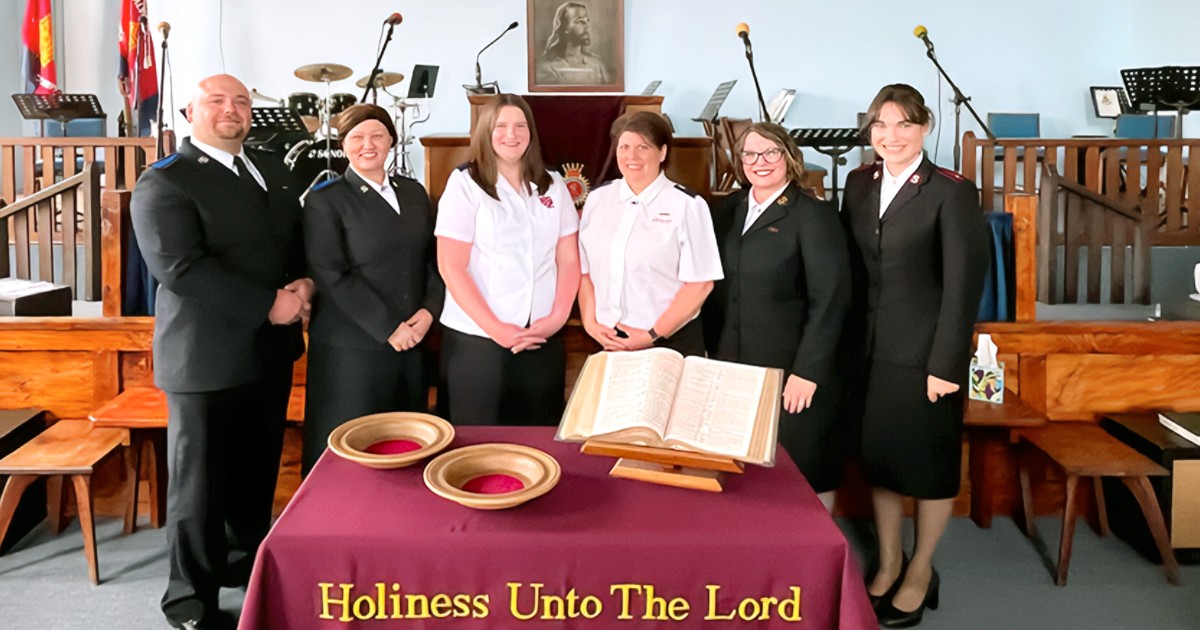
Each month, more than 850,000 Canadians receive food from a food bank, an increase of 26 percent from before the 2008-2009 recession. For those living on low or fixed incomes, keeping up with rising costs is an ongoing struggle. Fresh food is frequently more expensive than processed foods and, as a result, eating healthy is becoming less affordable. To meet this growing need, The Salvation Army offers various programs across the territory that help individuals and families fill their cupboards and improve their nutrition, such as these two food programs in New Brunswick and British Columbia.
Sally's Kitchen
As a result of the severe drought in the United States and parts of Canada this past summer, food prices are expected to increase dramatically in 2012 and 2013. In Sussex, N.B., however, low-income families are already feeling the pinch.
Seeing an opportunity to provide much-needed support for these families, The Salvation Army launched a new food mentoring program for young mothers.
“With the cost of living going up, we wanted to offer a program that would help them learn how to stretch their dollar further, while providing nutritious meals for their families,” says Major Judy Folkins, corps officer at Sussex Community Church.
Sally's Kitchen is a six-week program that teaches basic cooking skills, plus related tips and techniques such as meal planning, budgeting, food safety and nutrition.
For the first session of Sally's Kitchen, which began in April, The Salvation Army received 20 applications and chose seven low-income mothers who were similar in age and situation. Five of the participants were single parents, and some of them were living on as little as $600 per month.
The program was held at the corps on Thursdays from 10 a.m. to 2 p.m., and sessions started with devotions and prayer. Group discussion followed, covering topics such as reading food labels, using points and coupons to obtain the best deals, and finding creative ways to encourage children to eat healthy food.
“Sally's Kitchen provided a forum where participants and leaders could come together and learn how best to survive and thrive during these difficult times,” Major Folkins says. “At the first session, I could see that this would be a learning experience for all of us. The mothers had a lot to contribute—everyone was a teacher and a learner.”
After the discussion time, the women paired up and moved into the kitchen to start cooking. One person led the session with a demonstration and the women followed her example. The women learned how to prepare a variety of dishes from simple ingredients, and how to make some store-bought items—such as bread, baby food, cake and pasta sauce—from scratch.
Vanessa Parlee, whose children are two years old and nine months old, says that going to Sally's Kitchen was the highlight of her week.
“I really enjoyed the cooking and learning, and I applied everything I learned at home, including budgeting,” she says. “I had tried to budget before, but I didn't really know how to do it because it wasn't something I learned growing up.”
Like Parlee, Laura Herod found the program to be very educational and beneficial for her and her family.
 Above: Volunteer Cleon Sawyer prepares food hampers at the Chilliwack Care and Share food bank; below: Patsy Parlee, Vanessa Parlee and Amy Parlee make pizza dough at Sally's Kitchen
Above: Volunteer Cleon Sawyer prepares food hampers at the Chilliwack Care and Share food bank; below: Patsy Parlee, Vanessa Parlee and Amy Parlee make pizza dough at Sally's Kitchen
“My children just loved it,” says Herod, a single mother with children aged 14 and six. “When I brought leftovers home from the class, my daughter would try it and say, 'Oh my goodness, this is amazing. I want some more!'”
In Herod's house, a new beef stew recipe has been a big winner. In Parlee's home, it's macaroni and cheese.
“Instead of buying macaroni and cheese, I make my own now,” she says. “My two-year-old loves it—it's her favourite food—and it's healthier for her and my husband.”
But for Parlee, participating in Sally's Kitchen has meant much more than just learning new recipes and techniques.
“I really enjoyed getting to know everybody and having conversations with them,” she says. “We had so much in common. You didn't feel like you were by yourself; everything you went through, they went through, too.”
Herod, who was new to the corps when the program began, agrees. At the beginning, she knew only one of the other participants, but she quickly became friends with the others. “I felt comfortable and happy,” she says.
Major Folkins notes that even though the course was supposed to run for six weeks, it actually ran for 12 weeks because the women wanted to continue meeting together.
A new session of Sally's Kitchen began last month. Major Folkins hopes to run the program biannually.
Care and Share
Feeding hundreds of individuals and families each month is no small task, but the Salvation Army food bank and soup kitchen in Chilliwack, B.C., has tons of help—literally.
“We are surrounded by farms so, during the summer, we get about two tons of fresh produce every week,” says Brenda Armstrong, family services director at the Care and Share Centre. “The community looks after us. They're very good at making sure that we have the products we need, and if for any reason we put an SOS out there, within 24 hours, somebody will have met that need.”
The Salvation Army is the only registered food bank in Chilliwack and it is one of the five largest in British Columbia. It has been offering fresh food since it opened 26 years ago. When produce is donated, it goes to the soup kitchen first, and then to the food bank for distribution through food hampers. Any leftover produce is then placed in the Care and Share Centre's bread room.
By offering a soup kitchen, food bank and bread room, the centre is able to assist a wide range of people.
The soup kitchen is open for lunch Monday to Friday, and serves 125-200 adults a healthy, free meal every day. Of this number, there is a core group of about 60 people who eat at the soup kitchen every day.
“They come partly for the fellowship, but many of them do not have access to kitchen facilities and some do not know how to cook,” says Armstrong, adding that many soup kitchen clients are struggling with addictions or mental illness. Usually, clients are middle-aged, though Armstrong says she has seen a recent increase in the number of younger people.
Many soup kitchen clients also make use of the bread room, which is open three times a day and does not require clients to make an appointment to receive food.
The soup kitchen and bread room are complemented by the food bank, which primarily serves families. During an average month, the food bank distributes more than 500 food hampers to households ranging in size from one person to 10 people. Households can receive a hamper nine times per year (plus a Christmas hamper), but the food bank treats every case individually and will accommodate special circumstances.
Understanding a client's needs is important to providing the best assistance, says Armstrong, and that is why The Salvation Army makes appointments with each client.
“I really have an issue with the 'cattle lineup' approach, where everybody stands in line and they get a bag, but you never get to meet anybody,” Armstrong says. “Our clients sit down with one of our intake workers and we find out what their needs are.”
These appointments often result in referrals to other services, both at The Salvation Army and in the community, and they give intake workers an opportunity to offer nutritional advice and recipes to go with the food in the hampers.
By connecting with clients on an individual basis, Armstrong believes that The Salvation Army is also better able to serve them spiritually.
“We make sure they know that if they ever need to talk about their spiritual life, then there are people at the centre who are more than happy to listen and be a part of that,” she says.
“We need to show people how much God loves them, and one of the ways that we can do that is by meeting their physical needs,” Armstrong adds. “It has been really exciting to see how God uses the food bank and the soup kitchen to remind people of his great love.”
Plant a Row, Grow a Row
This summer and fall, the Care and Share Centre's food services will receive a produce boost thanks to the Plant a Row, Grow a Row (PARGAR) program. PARGAR is a national campaign that encourages gardeners to plant an extra row of vegetables and then donate the harvest to local food banks and soup kitchens.
In 2011, Food Matters Chilliwack—which co-ordinates PARGAR in the community—donated 572 kilograms of fresh produce to The Salvation Army. Organizers hope to exceed that total in 2012.
This year, food was donated in July, August and September. The final food drop-off will take place on October 13.










Leave a Comment